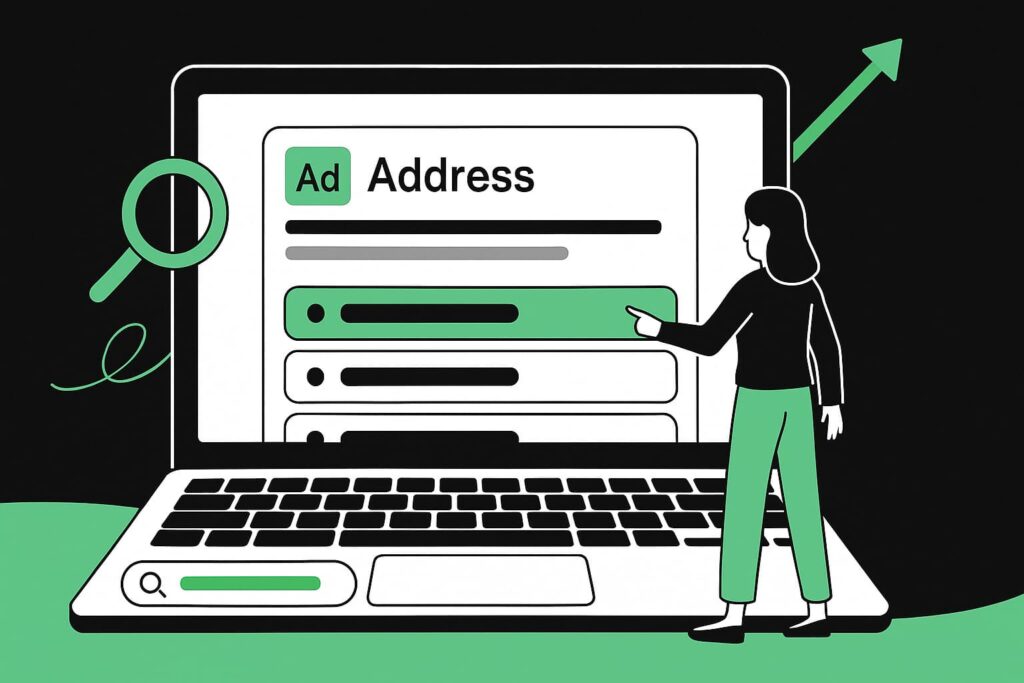What are sitelinks in Google Ads, and why do they matter for your campaigns? When you’re investing in paid search, visibility and relevance are everything. You want your ads to stand out, capture attention, and give searchers multiple reasons to choose your brand over a competitor. Sitelinks help you do exactly that.
Sitelinks enhance your search ads by adding extra clickable links beneath your main headline. They not only make your ad bigger on the results page but also give users more ways to interact with your brand. Whether you’re trying to drive conversions, highlight key pages, or improve user experience, sitelinks help you deliver more value with the same ad budget.
This guide breaks down what sitelinks are, why they matter, how to use them effectively, and the common mistakes to avoid.
What Are Sitelinks in Google Ads?
Sitelinks (officially called sitelink assets) are additional links that appear below your main Google Search ad. Each sitelink directs users to a specific page on your website such as “Pricing,” “Contact Us,” “Collections,” or “Testimonials.”
Think of them as a mini navigation menu built right into your ad. Instead of clicking your headline and then browsing around, searchers can jump straight to the page that matches their intent.
Sitelinks can appear differently depending on device:
- Desktop ads often show multiple sitelinks arranged in blocks with descriptions.
- Mobile ads may show sitelinks in a scrollable carousel or stacked layout.
You can add sitelinks at three levels:
- Account level – broad, brand-wide sitelinks (e.g., “About,” “Contact,” “Shop All”).
- Campaign level – tailored to specific product lines, offers, or audiences.
- Ad group level – the most granular option, aligned tightly with keywords and ad copy.
This flexibility makes sitelinks useful for almost any business, from e-commerce brands to service providers.
Why Sitelinks Matter: Key Benefits
Sitelinks are more than a visual upgrade. They directly affect performance, user experience, and brand perception.
1. Higher Click-Through Rates (CTR)
Sitelinks make your ad larger and more informative. That extra visibility tends to drive more clicks.
A 2025 guide from Marketing Hub Daily notes that ads using sitelinks can see click-through rates increase by up to 20% and highlights how powerful this asset can be when implemented correctly.
More clicks at the same impression volume means higher CTR, which can contribute to a better Quality Score and more efficient bidding over time.
2. Better User Experience
Searchers want speed and clarity. If someone already knows what they’re looking for like “pricing,” “book a call,” or “new arrivals”. Sitelinks let them skip the extra steps and land directly on that page.
This smoother journey:
- Reduces friction
- Shortens the path to conversion
- Makes your brand feel more helpful and intuitive
3. More Relevant, Intent-Matched Ads
Because sitelinks can be set at campaign or ad group level, you can:
- Match sitelinks to keyword themes
- Highlight pages that match user intent (research vs. purchase)
- Promote seasonal offers or time-sensitive campaigns
For example, someone searching “luxury bag sale” might see sitelinks like “Designer Bags,” “Limited Editions,” and “Member Discounts.” That alignment leads to higher-quality traffic.
4. Extra Real Estate on the SERP
In crowded industries, occupying more space is a competitive advantage. Sitelinks make your ad physically larger, pushing competitors further down the page.
The result: your brand looks more established and trustworthy at a glance.
Types of Sitelinks You Can Use
Here are practical sitelink types you can adapt for almost any brand:
Product or Category Sitelinks
Perfect for e-commerce and retail:
- New Arrivals
- Best Sellers
- Luxury Watches
- Designer Shoes
Conversion-Focused Sitelinks
Ideal for lead gen and service businesses:
- Get a Quote
- Book a Consultation
- View Pricing
- Schedule an Appointment
Educational Sitelinks
Great for high-consideration offers:
- How It Works
- Case Studies
- Blog
- Reviews
Support & Trust Sitelinks
- FAQs
- Contact Support
- Shipping & Returns
- Warranty Information
Example layout:
- Headline: Shop Luxury Goods – Sierra Exclusive
- Description: Premium collections crafted for world-class experiences
- Sitelinks: New Arrivals | Collections | Store Locator | Member Rewards
When Do Sitelinks Actually Show?
Adding sitelinks to your account doesn’t guarantee they’ll appear every time. Google decides when to show them based on factors like:
- Ad Rank
- Relevance to the user’s query
- Device type
- Available space on the results page
Sitelinks typically show more often when your ad ranks higher. On mobile, they may appear in a scrollable format or as a compact list.
Research on ad extensions shows that ads using extensions (including sitelinks) often achieve 10–15% higher CTR than ads without them, especially on mobile, where screen space is limited.
Even though display is automated, improving relevance and Quality Score increases how often your sitelinks appear.
How to Set Up Sitelinks in Google Ads
Creating sitelinks is straightforward. Here’s a simple walkthrough:
- Log in to Google Ads and go to Ads & Assets.
- Click Assets, then choose Sitelinks.
- Hit the + button to add a new sitelink.
- Choose where to apply it:
- Account
- Specific campaign
- Specific ad group
- Fill in the fields:
- Sitelink text – what users see (e.g., “New Arrivals,” “Get a Quote”)
- Final URL – the destination page
- Description lines – optional but highly recommended for extra ad space
- Save and preview how your sitelinks might appear with your ads.
You can also set start/end dates or schedules for limited-time offers, such as holiday campaigns or seasonal launches.
Pro tip: Always add descriptions. This often turns sitelinks into full, two-line blocks and significantly increases your ad’s presence on the results page.
Best Practices for High-Performing Sitelinks
To get the most from sitelinks, treat them like mini Google ads, not an afterthought.
1. Align Sitelinks with Intent
- Commercial queries: Use conversion-focused sitelinks like “View Pricing” or “Book a Consultation.”
- Research queries: Offer guides, blog posts, and “How It Works” pages.
2. Drive Traffic to High-Value Pages
Prioritize pages that:
- Convert well (forms, product pages, offers)
- Build trust (testimonials, case studies)
- Answer key questions (FAQs, shipping, returns)
3. Keep Text Short and Action-Oriented
Use clear verbs and avoid vague language:
- “Explore Collections”
- “Shop New Arrivals”
- “Get Member Rewards”
4. Don’t Skip Descriptions
Descriptions are optional in the interface but extremely valuable. They:
- Add more context for users
- Create a bigger visual block on the SERP
- Help differentiate similar-sounding sitelinks
5. Monitor and Test Regularly
Use asset-level reporting in Google Ads to check which sitelinks are getting the most clicks, impressions, and conversions.
Test variations like:
- Seasonal vs. evergreen offers
- Different CTAs
- New vs. returning customer flows
Pause underperforming sitelinks and double down on what works.
Real Examples of Effective Sitelinks
Luxury Retail Example
A luxury brand might use:
- New Arrivals
- Limited Editions
- Gift Guide
- Store Locator
Why it works: it highlights discovery, exclusivity, and convenience, all of which align closely with high-intent shoppers.
Service Business Example
A creative or consulting agency could use:
- Pricing
- Portfolio
- Book a Consultation
- Client Stories
Why it works: it gives prospects immediate access to proof (portfolio, client stories) and action-oriented pages (consultation, pricing).
Common Sitelink Mistakes to Avoid
Avoid these pitfalls if you want sitelinks to actually move the needle:
- Sending all sitelinks to the homepage
- Using long, vague, or jargon-heavy text
- Skipping descriptions and leaving space on the table
- Using the same generic sitelinks across every campaign
- Never reviewing performance or testing alternatives
Sitelinks are powerful, but only when they’re intentional and regularly optimized.
Conclusion
What are sitelinks in Google Ads? They are one of the most powerful, easy-to-implement ad enhancements available. By giving users more direct paths into your site, sitelinks:
- Improve CTR
- Enhance user experience
- Match user intent
- Help you stand out on Google
With thoughtful planning and ongoing optimization, sitelinks can become a major driver of campaign performance. They are especially powerful for high-end brands like Sierra Exclusive ads agency Sacramento that want their Google Ads to reflect premium quality and a user-focused design.
Frequently Asked Questions
How many sitelinks can you add in a Google Ads campaign or ad group?
You can add up to 20 sitelinks per campaign or ad group. However, Google typically shows only 2 to 6 sitelinks depending on device, ad rank, and available space. Adding more options gives Google flexibility to choose the best-performing sitelinks.
Do sitelinks cost extra in Google Ads, or do you pay only when someone clicks them?
Sitelinks do not cost extra to display. You only pay when a user clicks on a sitelink, just like a normal ad headline click. This makes sitelinks a no-cost way to increase visibility and engagement.
How do I add sitelinks to my Google Ads account step-by-step?
Go to Ads & Assets → Assets → Sitelinks, then click the + button to create a new sitelink. Add your link text, descriptions, and final URL. Choose the account, campaign, or ad group you want to apply it to, then save.
What are best practices for writing sitelink text and descriptions?
Keep the text short, clear, and action-oriented, such as “Shop New Arrivals” or “Get a Quote.” Use descriptions to add context and maximize SERP real estate. Always link to high-value, relevant landing pages that match the search intent.
Why aren’t my sitelinks showing in my Google Ads even though I added them?
Sitelinks only appear when an ad meets Google’s minimum Ad Rank and relevance requirements. They may also not show if there’s limited SERP space or if the sitelinks aren’t strong matches for the query. Ensuring high-quality ads and improving relevance increases their chances of appearing.
How do I measure and report the performance of sitelinks in Google Ads?
Go to your Assets section and select the Sitelink asset report to see individual click, impression, and CTR metrics. You can break down performance by campaign, ad group, or asset type. Use this data to pause weak sitelinks and optimize the ones driving engagement.
Can sitelinks appear on mobile differently than on desktop in Google Ads?
Yes, sitelinks often appear in a horizontal scrollable carousel on mobile instead of block-style layout. Mobile ads may show fewer sitelinks due to limited screen space. Google automatically adjusts the format to improve user experience on each device.




